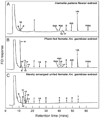Discriminative feeding behaviour of Anopheles gambiae s.s. on endemic plants in western Kenya
- PMID: 17373953
- PMCID: PMC2705332
- DOI: 10.1111/j.1365-2915.2007.00672.x
Discriminative feeding behaviour of Anopheles gambiae s.s. on endemic plants in western Kenya
Abstract
Anopheles gambiae Giles s.s. (Diptera: Culicidae) is known to feed on plant sugars, but this is the first experimental study to consider whether it discriminates between plant species. Thirteen perennial plant species were selected on the basis of their local availability within the vicinity of human dwellings and larval habitats of An. gambiae s.s. in western Kenya. Groups of 100 or 200 mosquitoes were released into cages either with a cutting of one plant type at a time (single-plant assay) or with cuttings of all 13 plants simultaneously (choice assay), respectively, and left overnight. In the choice assay, direct observations of the percentages of mosquitoes perching or feeding on each plant were recorded over four 1-h periods each night. For both types of assay, mosquitoes were recaptured and the percentage that had fed on plants was assessed by testing them individually for the presence of fructose. To identify which plants the choice-assay mosquitoes had fed on, gas chromatography (GC) profiles of samples of mosquito homogenates were compared with GC profiles of extracts from relevant parts of each plant. Four of the plants that were observed to have been fed on most frequently in the choice assay (Parthenium hysterophorus L., Tecoma stans L., Ricinus communis L., and Senna didymobotrya Fresen) were also shown to have been ingested most often by mosquitoes in both types of assay, suggesting that An. gambiae is differentially responsive to this range of plants, regardless of whether the plants were presented singly or mixed together. Significantly more females than males fed on plants, with the exception of P. hysterophorus L., one of the plants most frequently fed on. For most plant species (ten of 13), GC profiles indicated that An. gambiae obtained sugars primarily from flowers. The exceptions were P. hysterophorus L., Lantana camara L. and R. communis L., on which An. gambiae fed more often from leaves and stems than from flowers.
Figures




Similar articles
-
Effect of discriminative plant-sugar feeding on the survival and fecundity of Anopheles gambiae.Malar J. 2007 Aug 21;6:113. doi: 10.1186/1475-2875-6-113. Malar J. 2007. PMID: 17711580 Free PMC article.
-
Toxicity of six plant extracts and two pyridone alkaloids from Ricinus communis against the malaria vector Anopheles gambiae.Parasit Vectors. 2014 Jul 4;7:312. doi: 10.1186/1756-3305-7-312. Parasit Vectors. 2014. PMID: 24996560 Free PMC article.
-
Behavioural response of the malaria vector Anopheles gambiae to host plant volatiles and synthetic blends.Parasit Vectors. 2012 Oct 15;5:234. doi: 10.1186/1756-3305-5-234. Parasit Vectors. 2012. PMID: 23069316 Free PMC article.
-
Feeding and survival of the malaria vector Anopheles gambiae on plants growing in Kenya.Med Vet Entomol. 2004 Jun;18(2):108-15. doi: 10.1111/j.0269-283X.2004.00484.x. Med Vet Entomol. 2004. PMID: 15189235
-
Survival Value and Sugar Access of Four East African Plant Species Attractive to a Laboratory Strain of Sympatric Anopheles gambiae (Diptera: Culicidae).J Med Entomol. 2016 Sep 1;53(5):1105-1111. doi: 10.1093/jme/tjw067. J Med Entomol. 2016. PMID: 27247348 Free PMC article.
Cited by
-
Avoidance of the Plant Hormone Cis-Jasmone by Aedes aegypti Depends On Mosquito Age in Both Plant and Human Odor Backgrounds.J Chem Ecol. 2021 Sep;47(8-9):810-818. doi: 10.1007/s10886-021-01299-2. Epub 2021 Aug 31. J Chem Ecol. 2021. PMID: 34463894 Free PMC article.
-
The Nonartemisinin Sesquiterpene Lactones Parthenin and Parthenolide Block Plasmodium falciparum Sexual Stage Transmission.Antimicrob Agents Chemother. 2016 Mar 25;60(4):2108-17. doi: 10.1128/AAC.02002-15. Print 2016 Apr. Antimicrob Agents Chemother. 2016. PMID: 26787692 Free PMC article.
-
The Invasive American Weed Parthenium hysterophorus Can Negatively Impact Malaria Control in Africa.PLoS One. 2015 Sep 14;10(9):e0137836. doi: 10.1371/journal.pone.0137836. eCollection 2015. PLoS One. 2015. PMID: 26367123 Free PMC article.
-
Afrotropical sand fly-host plant relationships in a leishmaniasis endemic area, Kenya.PLoS Negl Trop Dis. 2021 Feb 8;15(2):e0009041. doi: 10.1371/journal.pntd.0009041. eCollection 2021 Feb. PLoS Negl Trop Dis. 2021. PMID: 33556068 Free PMC article.
-
Sugar-sensitive neurone responses and sugar feeding preferences influence lifespan and biting behaviours of the Afrotropical malaria mosquito, Anopheles gambiae.J Comp Physiol A Neuroethol Sens Neural Behav Physiol. 2015 Mar;201(3):317-29. doi: 10.1007/s00359-015-0978-7. Epub 2015 Jan 21. J Comp Physiol A Neuroethol Sens Neural Behav Physiol. 2015. PMID: 25605635
References
-
- Benedict MQ. Care and maintenance of anopheline mosquito colonies. In: Crampton JM, Beard CB, Louis C, editors. Molecular Biology Of Insect Disease Vectors: A Methods Manual. New York, NY: Chapman & Hall; 1997. pp. 3–12.
-
- Clements AN. The Biology of Mosquitoes, Vol. 2. Sensory Reception and Behaviour. U.K: CABI Publishing; 1999.
-
- Collins FH, Paskewitz SM. Malaria: current and future prospects for control. Annual Review of Entomology. 1995;40:195–219. - PubMed
-
- Deka MK, Singh K, Handique R, Singh K. Antifeedant and repellent effects of pongam (Pongamic pinnata) and wild sage (Lantana camara) on tea mosquito bug (Helopeltis theivora) Indian Journal of Agricultural Science. 1998;68:274–276.
-
- Fatope MO, Salihu L, Asante SK, Taheda Y. Larvicidal activity of extracts and triterpenoids from Lantana camara. Pharmaceutical Biology. 2002;40:564–567.
Publication types
MeSH terms
Substances
Grants and funding
LinkOut - more resources
Full Text Sources
Miscellaneous

